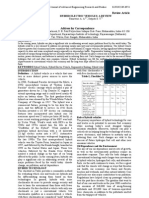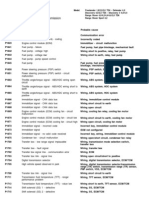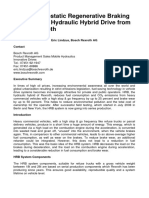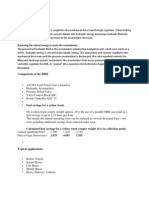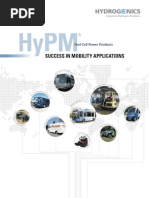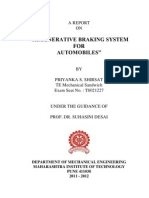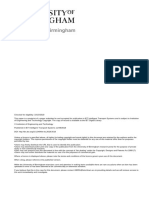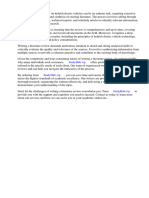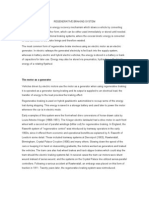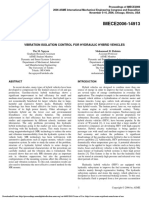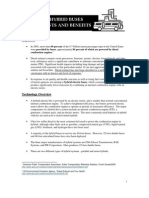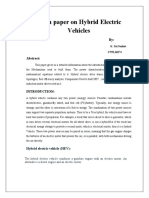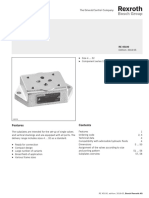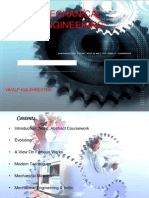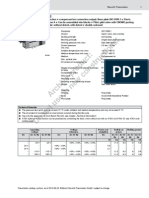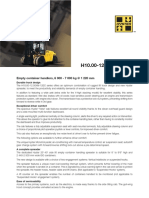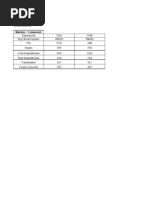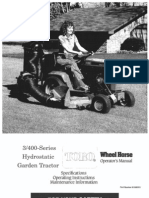Hydrostatic Regenerative Braking System Rexroth Ra98310 - 2010-08
Hydrostatic Regenerative Braking System Rexroth Ra98310 - 2010-08
Uploaded by
JairoHernanLoperaCopyright:
Available Formats
Hydrostatic Regenerative Braking System Rexroth Ra98310 - 2010-08
Hydrostatic Regenerative Braking System Rexroth Ra98310 - 2010-08
Uploaded by
JairoHernanLoperaOriginal Title
Copyright
Available Formats
Share this document
Did you find this document useful?
Is this content inappropriate?
Copyright:
Available Formats
Hydrostatic Regenerative Braking System Rexroth Ra98310 - 2010-08
Hydrostatic Regenerative Braking System Rexroth Ra98310 - 2010-08
Uploaded by
JairoHernanLoperaCopyright:
Available Formats
Linear Motion and
Assembly Technologies Service Pneumatics Hydraulics
Electric Drives
and Controls
Hydraulic Hybrids from Rexroth:
Hydrostatic Regenerative
Braking System HRB
Recover Energy Reduce Emissions
RA 98 310 08_10 sp1.indd 1 9/1/10 2:10 PM
2
A Win-Win for Operators and the Environment
Dwindling resources, increasing environmental awareness, and above all, rising fuel prices are affecting business decisions as
never before. The HRB Hydrostatic Regenerative Braking System helps meet increasingly strict environmental regulations
and reduces operating costs by saving fuel. The HRB system will provide superior return on investment whether youre a fleet
operator of refuse trucks or shuttle buses, a construction firm, a municipal operation running school or public transit buses,
or a loading dock or port operator.
RA 98 310 08_10 sp1.indd 2 9/1/10 2:10 PM
Hybrid: Two Pulling Together
Hybrid has its origin in the Greek language and means: Mixture or combination
of two things. Hybrid vehicles use two types of energy to attain optimum propulsion.
Combustion engine demand is reduced by hybrid technology, giving the user two big
advantages: lower fuel consumption and a significant reduction in emissions. The most
common hybrid technologies are electric and hydraulic hybrids.
Hybrid Versions
High energy density and low power density: The battery can absorb
a great deal of energy, but the charge time is relatively long, so it is not
possible to fully recapture the braking energy.
Energy is stored in batteries.
Typically found in passenger cars.
More detailed information about electric hybrid technology can also be
found at the Bosch Web page www.bosch.de under Hybrid Technology.
Characteristics of an electric hybrid:
Hydraulic hybrids are ideal for vehicles with frequent,
short start-stop cycles, such as public transit buses,
refuse trucks, forklifts, pneumatic tire rollers, telehandlers,
swap body movers and much more.
Characteristics of a hydraulic hybrid:
Excess motor power is continuously accumulated in a battery over
a longer time period (blue) and accessed as needed (light blue).
The kinetic energy from braking is fed to a hydraulic accumulator
(blue) and immediately reused for starting (light blue).
High power density and low energy density: There are limits to the
amount of energy the system can accumulate. However, it takes less time
to collect and store this energy, which can be called upon as needed.
The full braking energy is then fed to a hydraulic accumulator and stored.
3
RA 98 310 08_10 sp1.indd 3 9/1/10 2:10 PM
4 Operating Principles
Innovation and Quality Complement Each Other
The Rexroth focus on high-end hydraulic solutions, and our unique product line, is the basis for the HRB combining
proven components with a new, innovative braking and drive concept. That means high production quality and a variety
of existing components allowing Rexroth to tailor a hydraulic hybrid system to your design requirements. We also have
extensive knowledge and experience in electronic control of complex systems. The end result is that we can offer a custom-
tailored hydraulic hybrid powertrain that fits the needs of your application.
The HRB stores a vehicles kinetic energy,
which would otherwise be lost during
mechanical braking operation. This energy
is then available for powering the vehicle
and reducing primary energy use. To ensure
that the Rexroth Hydrostatic Regenerative
Braking System reaches its full potential, the
following conditions need to be met:
High vehicle mass and strong, active de-
celeration for accumulating a large amount
of energy in a short time.
Frequent starting and braking.
Low rolling resistance to store the maximum
braking energy.
Weight matters
High
Low High Braking Frequency
B
r
a
k
i
n
g
P
o
w
e
r
(
W
e
i
g
h
t
x
D
e
c
e
l
e
r
a
t
i
o
n
)
Cars
Trucks
Wheel Loaders
Telehandlers
Refuse Trucks
Forklifts
Swap Body Movers
Public Transit Buses
RA 98 310 08_10 sp1.indd 4 9/1/10 2:10 PM
5
Environment
Fewer harmful emissions, less pollution.
Help in meeting future emissions and environmental
requirements.
Reduced brake wear, lower braking noise, and less brake dust.
Advantages of the HRB
Function
High functional reliability and low risk of failure.
Simple maintenance and long service life.
Ideal solution for new systems or retrofits.
Costs
Significant reduction in operating costs.
Durable Rexroth components reduce maintenance needs.
More economical that other hybrid concepts.
Energy
Reduced fuel consumption to preserve energy.
Fuel-neutral system can be combined with diesel, gasoline,
or other types of motors.
Increased vehicle range.
For heavy vehicles with short, succeeding start-stop cycles,
Rexroth offers the Hydrostatic Regenerative Braking Systems
for capturing the braking energy.
The parallel HRB was developed especially for vehicles
with no hydrostatic drive. The HRB components are
installed in the vehicle as an ancillary system.
Optimal energy use with parallel HRB
RA 98 310 08_10 sp1.indd 5 9/1/10 2:10 PM
HRB parallel
for Vehicles with a Mechanical Drive Train
System and Advantages
The parallel HRB is a hydraulic hybrid for vehicles with no hydrostatic transmission: For example, vehicles used in refuse
collection and public transit buses. Use of an HRB system results in significant fuel savings of up to 25% and improved
acceleration depending on the focus of the application.
School Buses Shuttle Buses City Buses
6
RA 98 310 08_10 sp1.indd 6 9/1/10 2:11 PM
7
How the parallel HRB works
Storing braking energy
The hydraulic axial piston unit
is coupled to the mechanical drive train through
a gearbox
. When braking, the axial piston unit converts kinetic into hydraulic
energy and pumps hydraulic fluid into the pressure accumulator
, increasing
the pressure in the accumulator.
Reusing the stored energy to assist the vehicle drive
The pressurized hydraulic fluid in the accumulator drives the axial piston unit,
which now acts like a motor. Hydraulic energy is converted into kinetic energy.
The axial piston unit remains coupled to the mechanical drive train until the pres-
sure accumulator is discharged. The valve control block
controls the filling
and discharge cycle and protects the accumulator from excessive pressure.
The electronic controller
operates the HRB. In normal drive mode the
Hydrostatic Regenerative Braking System is decoupled.
Axial Piston Unit A4VSO + Gearbox, Hydraulic Pressure Accumulator, Pressure Relief Valve, Valve Control Block HIC, Electronic Contoller RC
Components of the parallel HRB
Simulated cost savings using the example of a refuse collection truck*
On a refuse truck (empty weight approximately 16 tons) the use of the parallel
HRB can result in saving of up to 2.25 liters (0.59 gallons) of fuel per hour.
The annual operating costs can thereby be reduced significantly without even
taking into account the additional savings potential of reduced brake wear.
7
The higher the fuel prices, the sooner your HRB pays for itself.
* For the simulation Rexroth uses the AMESim simulation tool.
Calculated fuel savings for a refuse truck (empty weight 16 t)
during operation
Annual operating hours 1,300 1,820 2,340
Fuel savings (liters per year) 2,925 4,095 5,265
CO
2
reduction (kg per year) 7,750 10,850 13,950
RA 98 310 08_10 sp1.indd 7 9/1/10 2:11 PM
Printed in the United States
RA 98 310/08.10
Bosch Rexroth Corporation
Hydraulics
2730 Research Drive
Rochester Hills, MI 48309
Telephone: (248) 2674000
Facsimile: (248) 8442698
www.boschrexroth.com/hrb
RA 98 310 08_10 sp1.indd 10 9/1/10 2:11 PM
You might also like
- John Deere 322, 330, 332, 430 Manual PDFDocument566 pagesJohn Deere 322, 330, 332, 430 Manual PDFPaul Bronco67% (3)
- Ladle TurretDocument27 pagesLadle Turretsati55009100% (6)
- Hybrid Electric VehiclesDocument6 pagesHybrid Electric VehiclesIslam FattouhNo ratings yet
- Rexroth A10vso Variable Axial Piston PumpDocument18 pagesRexroth A10vso Variable Axial Piston PumpJairoHernanLopera100% (8)
- ROVER Rover Fault Codes 0452Document1 pageROVER Rover Fault Codes 0452Дима Терлица0% (1)
- 72 60 00 PDFDocument48 pages72 60 00 PDFAnonymous 298xlo3uUNo ratings yet
- New+holland B110-B115 en Service+manual PDFDocument993 pagesNew+holland B110-B115 en Service+manual PDFAndresSuarez100% (2)
- HRB Hydrostatic Regenerative Braking System TheDocument7 pagesHRB Hydrostatic Regenerative Braking System ThexxshNo ratings yet
- How The HRB WorksDocument3 pagesHow The HRB Workssanojkp007No ratings yet
- Bosch Rexroth Hydraulic Hybrids - Ra98310 - 2010-08Document8 pagesBosch Rexroth Hydraulic Hybrids - Ra98310 - 2010-08MattH3No ratings yet
- VSD From Avec HHVDocument16 pagesVSD From Avec HHVmarkomasNo ratings yet
- 70-On The Dynamic Behavior of Series Hydraulic Hybrid VehicleDocument16 pages70-On The Dynamic Behavior of Series Hydraulic Hybrid VehicleGalal RabieNo ratings yet
- Hydraulic Hybrid Vehicles Hydraulic Engines Hydraulic Hybrid Technology Hydraulic Hybrid System For Four Wheeler SeriesDocument1 pageHydraulic Hybrid Vehicles Hydraulic Engines Hydraulic Hybrid Technology Hydraulic Hybrid System For Four Wheeler SeriesDIVAS NEGINo ratings yet
- A Review of Regenerative Braking SystemsDocument24 pagesA Review of Regenerative Braking SystemssudalaiyandiNo ratings yet
- Presentation1 RbsDocument14 pagesPresentation1 RbsSpoil KidNo ratings yet
- Hybrid Vehicles RUSHIKESHDocument15 pagesHybrid Vehicles RUSHIKESHVishal SinghNo ratings yet
- Hydraulic Regenerative Braking SystemDocument12 pagesHydraulic Regenerative Braking SystemAnand KesarkarNo ratings yet
- Ajmer SinghhDocument53 pagesAjmer Singhhmd washiqeNo ratings yet
- Machinedesign 3353 Mechanical Drives Hydrostatic DrivesDocument3 pagesMachinedesign 3353 Mechanical Drives Hydrostatic DrivesQuyềnNo ratings yet
- Hybrid Electric VehiclesDocument11 pagesHybrid Electric VehiclesRadoi Dinu-ValentinNo ratings yet
- Design and Fabrication of Solar Transport Vehicle: V.Naveen Prabhu and N.ManigandanDocument6 pagesDesign and Fabrication of Solar Transport Vehicle: V.Naveen Prabhu and N.ManigandanDida KhalingNo ratings yet
- Hydraulic Hybrid From Rexroth: Hydrostatic Regenerative Braking System HRBDocument4 pagesHydraulic Hybrid From Rexroth: Hydrostatic Regenerative Braking System HRBzinebNo ratings yet
- Hybrid Hydraulic Vehicle: Power To Get The Job DoneDocument2 pagesHybrid Hydraulic Vehicle: Power To Get The Job DoneadeindrawijayaNo ratings yet
- ExcavatorDocument10 pagesExcavatorAnonymous OfU0JSNo ratings yet
- Success in Mobility ApplicationsDocument8 pagesSuccess in Mobility ApplicationsPaolo VelcichNo ratings yet
- HybridDocument4 pagesHybridVignesh AsokNo ratings yet
- Diesel Electric Hybrid VehiclesDocument8 pagesDiesel Electric Hybrid VehiclesLászló KovácsNo ratings yet
- 16271A0334. SeminarDocument13 pages16271A0334. SeminaranilbabuNo ratings yet
- High Performance and Low CO From A Flybrid® Mechanical Kinetic Energy Recovery SystemDocument12 pagesHigh Performance and Low CO From A Flybrid® Mechanical Kinetic Energy Recovery SystemApoorva PanchalNo ratings yet
- Why The Interest in Hybrid Technology?: Bryan Nelson - Caterpillar, IncDocument11 pagesWhy The Interest in Hybrid Technology?: Bryan Nelson - Caterpillar, IncAnoj pahathkumburaNo ratings yet
- MR and ER Based Semiactive Engine Mounts A ReviewDocument22 pagesMR and ER Based Semiactive Engine Mounts A Reviewhan21256102No ratings yet
- Renius 3Document18 pagesRenius 3ManuelNo ratings yet
- Hybrid Electric VehiclesDocument16 pagesHybrid Electric VehiclesmedNo ratings yet
- Regenerative Braking SystemDocument27 pagesRegenerative Braking Systemapi-1977578380% (5)
- Seminar ReportDocument24 pagesSeminar ReportPriyanka Shirsat100% (1)
- Vael (2011) The E-HydridDocument15 pagesVael (2011) The E-HydridGeorges VaelNo ratings yet
- Institute of Road and Transport Technology: Hydraulic Hybrid VehiclesDocument13 pagesInstitute of Road and Transport Technology: Hydraulic Hybrid VehiclesgowthamarajNo ratings yet
- Hydrostatic Drives Lect8Document5 pagesHydrostatic Drives Lect8Rehan Rashid100% (1)
- Dissertation On Hybrid VehiclesDocument6 pagesDissertation On Hybrid VehiclesBestWriteMyPaperWebsiteUK100% (1)
- Sites Default Files Publications CECE-CEMA-CO2-SuccessStoriesDocument32 pagesSites Default Files Publications CECE-CEMA-CO2-SuccessStoriestsar_philip2010No ratings yet
- BY Pratik Kumar Singh Roll No. 16529Document18 pagesBY Pratik Kumar Singh Roll No. 16529Yogesh AnandNo ratings yet
- IET A New Traction Motorsizing Strategy Accepted VersionDocument10 pagesIET A New Traction Motorsizing Strategy Accepted Versionnamanbhatia505No ratings yet
- Literature Review of Hybrid Electric VehicleDocument8 pagesLiterature Review of Hybrid Electric Vehicleafdtrtrwe100% (1)
- Regenerative Braking SystemDocument15 pagesRegenerative Braking SystemVinay KumarNo ratings yet
- Loader Power-Split Transmission System Based On A Planetary Gear SetDocument8 pagesLoader Power-Split Transmission System Based On A Planetary Gear SetsughieantoNo ratings yet
- PURPOSE of "Hydrogen Solutions - Hydrogen Generator" (Short HS-VG)Document3 pagesPURPOSE of "Hydrogen Solutions - Hydrogen Generator" (Short HS-VG)Reggie RegaladoNo ratings yet
- Regenerative Braking SystemDocument4 pagesRegenerative Braking SystemAkash MishraNo ratings yet
- The Present and Future of Hybrid and Electric VehiclesDocument12 pagesThe Present and Future of Hybrid and Electric VehiclesrajmehaNo ratings yet
- Nguyen 2006Document7 pagesNguyen 2006Agus LutantoNo ratings yet
- Hybrid Vehicles ThesisDocument7 pagesHybrid Vehicles Thesisbethhernandezpeoria100% (2)
- Hybrid Buses Costs and Benefits: Key FactsDocument6 pagesHybrid Buses Costs and Benefits: Key FactsseanbagoNo ratings yet
- Acknowledgement:: C. B. ShivayogimathDocument16 pagesAcknowledgement:: C. B. ShivayogimathKiran PatilNo ratings yet
- Hybrid Vech Part 1Document15 pagesHybrid Vech Part 1Ravi KumarNo ratings yet
- Energy Efficient Hydraulic Hybrid Drives: January 2009Document15 pagesEnergy Efficient Hydraulic Hybrid Drives: January 2009Muh AmmadNo ratings yet
- Department of Mechanical EngineeringDocument23 pagesDepartment of Mechanical EngineeringMail ManNo ratings yet
- Term Paper On HEVDocument11 pagesTerm Paper On HEVsaisanketNo ratings yet
- Regen Braking PresentationDocument19 pagesRegen Braking Presentationabhishek_kumar_5100% (1)
- 6.hybrid VehicleDocument12 pages6.hybrid VehicleawesomeyogeshwarNo ratings yet
- The Present and Future of Hybrid and Electric VehiclesDocument12 pagesThe Present and Future of Hybrid and Electric VehiclesvishiwizardNo ratings yet
- Seminar ReportDocument28 pagesSeminar ReportSwathi PrasadNo ratings yet
- Ee Mte ReportDocument37 pagesEe Mte Reportkatyani guptaNo ratings yet
- Discovering Toyota Rav4 Hybrid: Your Easy Guide to Eco-Friendly DrivingFrom EverandDiscovering Toyota Rav4 Hybrid: Your Easy Guide to Eco-Friendly DrivingNo ratings yet
- Cars And Auto Accessories: The Little Gadgets That Personalise Luxury...From EverandCars And Auto Accessories: The Little Gadgets That Personalise Luxury...No ratings yet
- Introduction to Hybrid Vehicle System Modeling and ControlFrom EverandIntroduction to Hybrid Vehicle System Modeling and ControlRating: 4 out of 5 stars4/5 (1)
- 2 Insert Valves 2012-07Document30 pages2 Insert Valves 2012-07JairoHernanLoperaNo ratings yet
- Varitec Overview Hawe LHK LDHV LHTDocument4 pagesVaritec Overview Hawe LHK LDHV LHTJairoHernanLoperaNo ratings yet
- Hydraulics - Graphic Symbols ValvesDocument1 pageHydraulics - Graphic Symbols ValvesJairoHernanLoperaNo ratings yet
- 5 Brochure Precision PlusDocument4 pages5 Brochure Precision PlusJairoHernanLoperaNo ratings yet
- "A" Pilotair Valve Block Type and Panel MountedDocument24 pages"A" Pilotair Valve Block Type and Panel MountedJairoHernanLoperaNo ratings yet
- 8 Cavities 2012-07Document39 pages8 Cavities 2012-07JairoHernanLoperaNo ratings yet
- Re45100 - 2016-05 PLACAS DE VALVULAS PDFDocument60 pagesRe45100 - 2016-05 PLACAS DE VALVULAS PDFJairoHernanLoperaNo ratings yet
- Dimensionamiento Cilindros HidráulicosDocument4 pagesDimensionamiento Cilindros HidráulicosJairoHernanLoperaNo ratings yet
- Collins - Good Wood Joints PDFDocument120 pagesCollins - Good Wood Joints PDFJairoHernanLoperaNo ratings yet
- Aplicaciones Process FiltrationDocument93 pagesAplicaciones Process FiltrationJairoHernanLoperaNo ratings yet
- TTC Catalog - EN 2013Document148 pagesTTC Catalog - EN 2013JairoHernanLoperaNo ratings yet
- HE-Catalog 2014 enDocument408 pagesHE-Catalog 2014 enJairoHernanLoperaNo ratings yet
- Mechanical Engineering: Vikalp KulshresthaDocument93 pagesMechanical Engineering: Vikalp KulshresthaJairoHernanLoperaNo ratings yet
- Rexroth Oil Cleanliness Booklet PDFDocument44 pagesRexroth Oil Cleanliness Booklet PDFJairoHernanLopera100% (1)
- 5-3-Way Valve, Series ISO2Document5 pages5-3-Way Valve, Series ISO2JairoHernanLoperaNo ratings yet
- CPMDocument84 pagesCPMbiabamanbemanNo ratings yet
- Hyster h1200 XM 12ecDocument6 pagesHyster h1200 XM 12ecHumberto Augusto de BorbaNo ratings yet
- A1 Specifications: EmissionDocument3 pagesA1 Specifications: EmissionUmar ShamsudinNo ratings yet
- 797A Vs 797BDocument57 pages797A Vs 797BCristian Quintana VillarNo ratings yet
- Frame and Running Gear: Downloaded From Manuals Search EngineDocument72 pagesFrame and Running Gear: Downloaded From Manuals Search EngineAlberto Sánchez PrietoNo ratings yet
- Caterpillar Motoniveladora ManualDocument102 pagesCaterpillar Motoniveladora ManualAndres Jarrin100% (3)
- U340 441E DescriptionDocument25 pagesU340 441E Descriptionruslan1580100% (1)
- 407 Gold SFC 29 Sales Pitch Bs6Document22 pages407 Gold SFC 29 Sales Pitch Bs6Ankur MestryNo ratings yet
- CLAT Classroom Prep Material: MathematicsDocument8 pagesCLAT Classroom Prep Material: MathematicsHrituraj SrivastavaNo ratings yet
- 02 201300 005 enDocument106 pages02 201300 005 entrung mai100% (3)
- Xp500 Tmax Technical Orientation Guide: Features and BenefitsDocument45 pagesXp500 Tmax Technical Orientation Guide: Features and BenefitsmraleNo ratings yet
- Tulsa Winch Planetary Hoists Specifications PDFDocument5 pagesTulsa Winch Planetary Hoists Specifications PDFKSR100% (1)
- How Four Wheels Drive WorksDocument5 pagesHow Four Wheels Drive WorksjinmenchieNo ratings yet
- Removal: (A) (B) (B) LockDocument4 pagesRemoval: (A) (B) (B) Lockjoe nathanNo ratings yet
- Contents.: The New BMW M5Document47 pagesContents.: The New BMW M5Paul TanNo ratings yet
- Commerciall Vehicle Range: Il L 44 IDocument4 pagesCommerciall Vehicle Range: Il L 44 Ichara459254100% (1)
- Mini ProjectDocument18 pagesMini ProjectSamyakRajBansalNo ratings yet
- Elecon EngineeringDocument8 pagesElecon EngineeringA_KinshukNo ratings yet
- Drive Train PDFDocument46 pagesDrive Train PDFHuseyin TaskinNo ratings yet
- Gearbox Bearing Fitting PDFDocument2 pagesGearbox Bearing Fitting PDFmxckcxzlm.c,No ratings yet
- S5 Sportback TFSI® Prestige Tiptronic®Document10 pagesS5 Sportback TFSI® Prestige Tiptronic®Vishal NaikNo ratings yet
- WheelHorse 300 and 400 Series Owners ManualDocument28 pagesWheelHorse 300 and 400 Series Owners ManualKevins Small Engine and Tractor Service83% (6)
- JCB 926Document4 pagesJCB 926Nenad NedeljkovicNo ratings yet
- 1CX CatalogoDocument24 pages1CX CatalogoYvanNo ratings yet
- Section 55 - Electrical System - Chapter 12Document40 pagesSection 55 - Electrical System - Chapter 12احمد الشبراوى الشبراوىNo ratings yet


